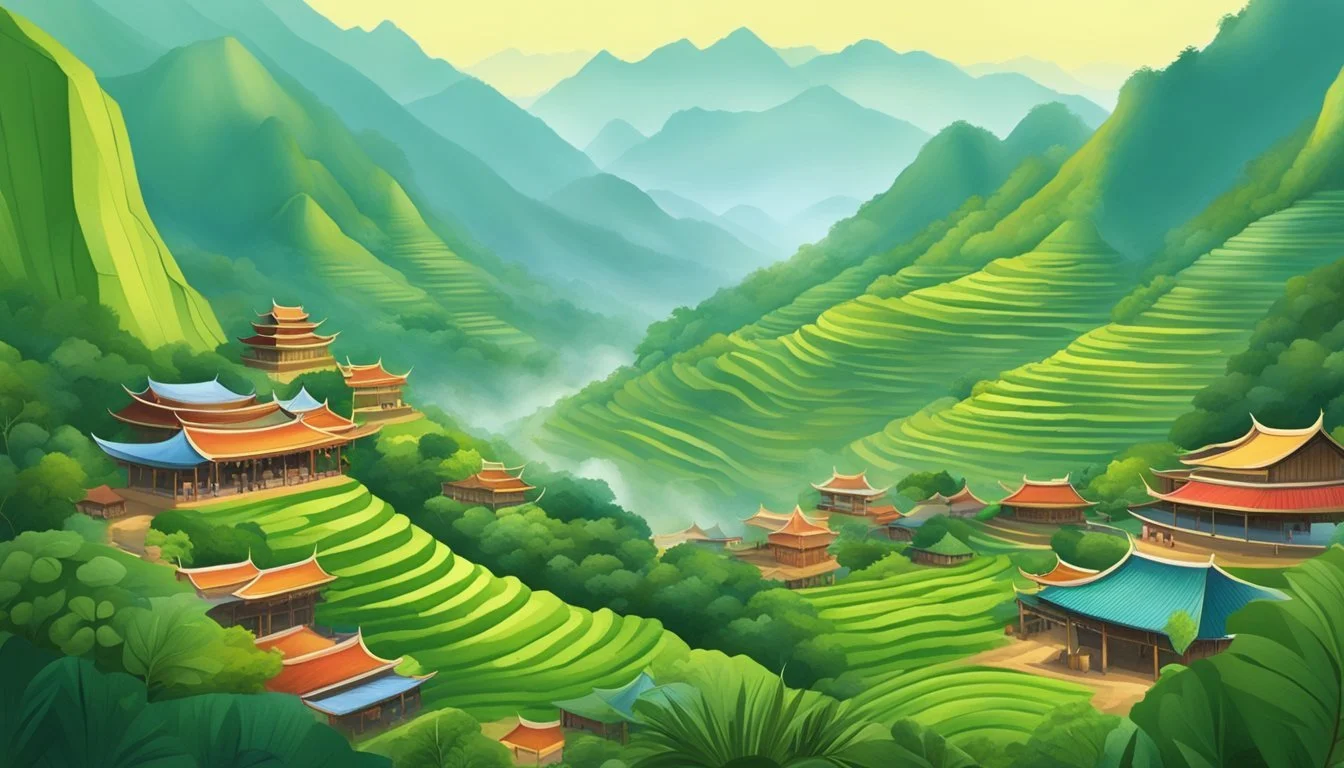6 Compelling Documentaries on Laos
Unveiling Southeast Asian History and Culture
Documentaries offer a window into the rich culture, complex history, and contemporary challenges of Laos. These films provide viewers with an opportunity to explore this Southeast Asian nation through the lens of skilled filmmakers and storytellers.
For those seeking to deepen their understanding of Laos, documentaries serve as valuable educational tools, shedding light on topics ranging from the country's natural beauty to its tumultuous past. The six compelling documentaries featured in this article capture diverse aspects of Laotian life, society, and landscape, presenting a multifaceted portrait of this often-overlooked nation.
1) The Betrayal - Nerakhoon
The Betrayal - Nerakhoon is a powerful documentary that chronicles the journey of a Laotian family from their homeland to the United States. Directed by Ellen Kuras and Thavisouk Phrasavath, the film was shot over an impressive 23-year period.
At its core, the documentary explores the aftermath of the secret war waged by the U.S. in Laos during the Vietnam War. It focuses on Thavi Phrasavath and his family, who fought alongside American forces but were subsequently abandoned.
The film delves into the political, cultural, and emotional challenges faced by the Phrasavath family as refugees. It portrays their journey from Laos to Brooklyn, offering a personal and poetic perspective on their experiences.
Kuras, known for her work as a cinematographer, makes her directorial debut with this Academy Award-nominated film. The unique collaboration between Kuras and Phrasavath, who serves as both subject and co-director, adds depth to the storytelling.
The Betrayal - Nerakhoon has garnered critical acclaim, winning the Spectrum Award at the Full Frame Documentary Film Festival and receiving nominations for an Oscar and an Independent Spirit Award.
2) Bomb Harvest
"Bomb Harvest" is a compelling documentary directed by Kim Mordaunt that sheds light on the lasting impact of the Vietnam War in Laos. The film follows Australian bomb disposal specialist Laith Stevens as he works to clear unexploded ordnance left behind from the conflict.
Stevens trains local Laotians in the dangerous art of bomb disposal, aiming to make their country safer. The documentary highlights the ongoing threat posed by unexploded bombs, which continue to claim lives decades after the war's end.
The film captures the stark contrast between the beauty of Laos and the deadly remnants of war hidden beneath its surface. It showcases the bravery of those working to clear the land and the resilience of local communities living alongside this constant danger.
"Bomb Harvest" offers a unique perspective on the long-term consequences of war and the challenges of post-conflict recovery. It brings attention to an often-overlooked issue, emphasizing the importance of continued efforts to remove these deadly legacies.
3) On the Banks of the Mekong
The Mekong River plays a central role in Laotian life and culture. Several documentaries explore the communities and ecosystems that thrive along its banks.
"A journey of discovery on the Mekong through Laos" showcases the river's rich biological diversity. This film highlights why the Mekong is often called "the mother of waters" in the region.
The documentary examines how the Mekong serves as a vital transport route and water source for local populations. It offers viewers a glimpse into the daily lives of people who depend on the river.
Along the fertile banks of the Mekong, vast rice paddies stretch as far as the eye can see. Rice forms the foundation of the Laotian diet, consumed three times daily by many residents.
"Spirits of the Mekong" follows Leua, an itinerant vendor who travels the Upper Mekong with his family. This intimate portrait reveals the river's importance to nomadic traders and their way of life.
These documentaries capture the Mekong's role as both a lifeline and a cultural touchstone for the people of Laos. They provide insight into a unique way of life shaped by one of Asia's great rivers.
4) River of Victory
River of Victory is a documentary film directed by Trevor Wright that explores life in Cambodia's Stung Meanchey landfill. The film focuses on Sang Ly, a young Cambodian mother, and her complex relationship with the landfill where she resides.
The documentary provides a raw glimpse into the harsh realities faced by those living in one of Cambodia's largest garbage dumps. It showcases the daily struggles and resilience of the community that calls this challenging environment home.
Through Sang Ly's story, viewers gain insight into the lives of those who make a living by scavenging through the mountains of waste. The film highlights the ingenuity and determination required to survive in such difficult circumstances.
River of Victory sheds light on important social issues, including poverty, environmental concerns, and the human spirit's capacity to endure. It offers a unique perspective on a community often overlooked by mainstream media.
The documentary serves as a powerful tool for raising awareness about the living conditions in Stung Meanchey and similar locations around the world. It encourages viewers to reflect on global inequality and the impact of consumerism.
5) Power of the River: Expedition to the Heart of Water in Laos
"Power of the River: Expedition to the Heart of Water in Laos" is a captivating documentary that explores the vital waterways of Laos. The film follows a team of local guides and international adventurers as they journey down the country's majestic rivers.
The documentary showcases Laos' stunning natural beauty and rich biodiversity. It highlights the importance of rivers to Laotian culture, livelihoods, and ecosystems.
Throughout their expedition, the team encounters challenges and discovers hidden wonders. They navigate rapids, camp on pristine riverbanks, and interact with riverside communities.
The film also examines the threats facing Laos' rivers, including hydroelectric dam projects. It presents perspectives from local residents, environmental experts, and government officials on water resource management.
"Power of the River" combines breathtaking cinematography with insightful interviews. It offers viewers a unique glimpse into the heart of Laos' aquatic environments and the complex issues surrounding their preservation.
This documentary serves as both an adventure narrative and an educational tool. It aims to raise awareness about the ecological and cultural significance of Laos' rivers.
6) The Road from War: A Southeast Asian Odyssey
"The Road from War: A Southeast Asian Odyssey" offers a captivating exploration of post-conflict recovery in Southeast Asia. This documentary examines the long-term effects of war on countries like Vietnam, Laos, and Cambodia.
The film traces the journey of individuals and communities rebuilding their lives after decades of conflict. It showcases resilience in the face of adversity and highlights efforts to heal collective trauma.
Viewers gain insight into the challenges of economic development and social reconciliation in these nations. The documentary features interviews with local residents, historians, and aid workers, providing diverse perspectives on the region's transformation.
Stunning visuals capture the natural beauty of Southeast Asia alongside remnants of war. The contrast between ancient temples, bustling cities, and former battlefields illustrates the complex tapestry of history and progress.
"The Road from War" also explores how tourism and international aid have influenced recovery efforts. It raises questions about the balance between preserving history and embracing modernization in these rapidly changing societies.
Cultural and Historical Context of Laos
Laos has a rich cultural heritage shaped by centuries of foreign influence and indigenous traditions. Documentaries offer valuable insights into the country's complex history and vibrant cultural landscape.
Historical Overview of Laos
Laos traces its origins to the ancient Lan Xang kingdom founded in the 14th century. The country experienced periods of independence, foreign rule, and civil conflict. French colonization in the late 19th century significantly impacted Lao society and governance.
Laos gained independence in 1953 but was soon embroiled in the Vietnam War. The conflict led to extensive bombing campaigns and political upheaval. In 1975, the communist Pathet Lao movement took control, establishing the Lao People's Democratic Republic.
Since the 1980s, Laos has gradually opened up to the world. Economic reforms and increased tourism have brought rapid changes to parts of the country. Many rural areas, however, maintain traditional ways of life.
Cultural Significance of Documentaries
Documentaries play a crucial role in preserving and showcasing Lao culture. They capture traditional practices, rituals, and lifestyles that are increasingly rare in urban areas. Films often highlight the diversity of Laos' ethnic groups and their unique customs.
Many documentaries focus on the challenges facing Lao communities. These include environmental issues, development projects, and the loss of traditional knowledge. By presenting these topics, filmmakers raise awareness and promote cultural preservation efforts.
Documentaries also serve as historical records. They document important events, people, and places in Lao history. This visual archive helps educate younger generations about their heritage and fosters cultural pride.
Impact of Documentaries on Global Perception
Documentaries about Laos have played a crucial role in shaping international understanding of the country. These films have brought attention to Laos' rich culture, complex history, and current challenges.
Raising Awareness Through Storytelling
Documentaries use compelling narratives to educate viewers about Laos' past and present. Films like "The Most Secret Place on Earth" shed light on the country's involvement in the Vietnam War. This increased global awareness of Laos' role in the conflict and its lasting effects.
Other documentaries highlight environmental issues in Laos. "The Mekong River with Sue Perkins" explores the impact of dam construction on local communities and ecosystems. Such films prompt discussions about sustainable development and conservation efforts.
Documentaries also showcase Lao traditions and daily life. "A Thousand Fires" portrays the struggles of rural families, fostering empathy and understanding among international audiences.
Influence on Tourism and Economy
Documentaries have sparked interest in Laos as a travel destination. Films showcasing the country's natural beauty, like "Laos: Jewel of the Mekong," have attracted adventure seekers and eco-tourists.
This increased visibility has boosted Laos' tourism industry. More visitors mean more revenue for local businesses and communities. However, it also raises concerns about preserving cultural authenticity and managing environmental impacts.
Some documentaries promote responsible tourism practices. They educate viewers on how to respect local customs and support sustainable initiatives when visiting Laos. This helps balance economic benefits with cultural and ecological preservation.
Challenges Faced by Filmmakers
Creating documentaries about Laos presents unique hurdles for filmmakers. From navigating complex cultural sensitivities to overcoming practical limitations in remote areas, these challenges shape the final product and the storytelling process.
Ethical Considerations in Documentary Filmmaking
Documentary filmmakers in Laos must carefully balance truth-telling with respect for local customs and government sensitivities. Portraying sensitive topics like political history or social issues requires tact and discretion. Filmmakers often struggle with how to present controversial subjects without endangering their subjects or jeopardizing their ability to work in the country.
Obtaining informed consent from participants can be complicated by language barriers and differing cultural norms around privacy. Filmmakers must ensure their work doesn't exploit or misrepresent vulnerable communities. This often involves building trust over extended periods and allowing subjects to review footage.
Logistical and Technical Barriers
Laos' limited infrastructure poses significant challenges for film production. Remote locations may lack reliable electricity, necessitating generators and battery backups. Transportation of equipment on rough roads or by boat can be risky and time-consuming.
The tropical climate presents additional hurdles. High humidity can damage sensitive gear, while monsoon rains may disrupt shooting schedules. Filmmakers must protect their equipment from these elements and plan for weather-related delays.
Limited local film industry resources mean crews often need to import specialized equipment. This increases costs and can lead to customs complications. Finding skilled local crew members may also be difficult, especially for technical roles.






